
The Best of Everything
Encyclopedia Entry • Films Main
Love on the Run
1936

Critics' Reviews • Our Reviews • Movie Posters • Lobby Cards • Misc. Images
Click here to see photos from the film.
US release: 11/20/36.
VHS release: 7/21/93. Warner Archive DVD release: 3/23/09. Cast: Joan Crawford (as "Sally Parker"), Clark Gable, Franchot Tone, Reginald Owen, Mona Barrie, Ivan Lebedeff, Charles Judels, William Demarest. Credits: From the story by Alan Green and Julian Brodie (or Breen, depending on source). Screenplay: John Lee Mahin, Manuel Seff, and Gladys Hurlbut. Producer: Joseph L. Mankiewicz. Director: W.S. Van Dyke. Camera: Oliver T. Marsh. Costumes: Adrian. Editor: Frank Sullivan.
Plot Summary: Having turned down the opportunity to produce Frank Capra's It Happened One Night (1934), MGM's Louis B. Mayer had second thoughts when the Capra film swept the 1935 Oscars ceremony. Mayer hastily commissioned an It Happened One Night wannabe titled Love on the Run, tailored for the talents of Joan Crawford and Clark Gable (who, of course, had starred in the Capra picture, and had copped one of those Oscars). Gable and Franchot Tone play rival journalists Michael Anthony and Barnabas Pells, who travel the length and breadth of Europe to outscoop one another. Crawford portrays madcap heiress Sally Parker, who is engaged to marry fortune-hunting Prince Igor (Ivan Lebedeff). Whereas in It Happened One Night the heroine (Claudette Colbert) linked up with Gable in order to expedite her elopement with the wrong man, in Love on the Run Crawford seeks out Gable's help to escape her impending marriage with Prince Igor. The two stars combine their flight across Europe with business, dogging the trail of international aviator Baron Spandermann (Reginald Owen), whom Anthony suspects of being a spy. Pells goes along with Anthony and Parker, and soon all three of them are tied up (literally, in Pells' case) with an espionage ring. While it is Clark Gable who ends up with Joan Crawford at fadeout time, it was Franchot Tone who claimed her as his bride in real life. ~ Hal Erickson, All Movie Guide
Total Gross: $1,862,000 ($677,000 profit)
|
J.T.M. in the New York Times November 28,1936
A slightly daffy cinematic item of absolutely no importance, "Love on the Run," is currently at the Capitol, with Clark Gable, Joan Crawford and Franchot Tone in roles that by now are a bit stale. In all good conscience, the film ought to bow, in turn, to several distinguished antecedents, for it has borrowed liberally here and there of tried and true screen devices and situations.
Mr. Gable and Mr. Tone are allegedly rival foreign correspondents for New York newspapers, but Mr. Tone is too easily outwitted to be called a rival. Their current assignments are a stratosphere flier who turns out to be a spy (Reginald Owen), and an heiress (Joan Crawford), who is scheduled to marry royalty, but on reconsideration turns out her prince.
In the course of helping Miss Crawford escape Mr. Gable unmasks the spy, leads the heiress over the face of Europe at a dizzy pace by air, auto and oxcart; invades Fontainebleu for a night's lodging, arousing new hallucinations in the mind of the unstable caretaker; and eventually leads Miss Crawford to the altar after a characteristic interlude of trumpeted vituperation on his part and scorned woman fury on hers. Mr. Tone, meanwhile, tags along, permitting himself to be hoodwinked thoroughly from London to Nice.
Honors must go to Mr. Tone, Reginald Owen and Donald Meek. W. S. Van Dyke has injected a few of his own tested touches, and some in the Rene Clair and Frank Capra manner, with a resulting mad pace and pleasing familiarity for the audience.
Howard Barnes in the New York Herald Tribune (1936): A lot of gay nonsense has been strung together....a fantastic and insubstantial narrative, with the result that it is almost continuously amusing and frequently hilarious... Miss Crawford, of the big eyes and flowing hair, turns in a surprisingly volatile and amusing performance as the heiress.
crazy4cinema.com: This certainly isn't one of the most memorable Gable or Crawford flicks, but their onscreen presence and chemistry overpower the thin plot, making this an enjoyable romantic comedy....Gable and Crawford are wonderfully entertaining, hamming it up for the camera and making the most of their time together. There's nothing surprising to be found here, but fans of either star will enjoy themselves enough. |
If you've seen Love on the Run and would like to share your review here, please e-mail me. Include a picture of yourself or avatar to accompany your review, as well as a star-rating (with 5 stars the best) and any of your favorite lines from the film.
|
Rating:
Until this evening, I hadn't watched 1936's Love on the Run in almost 15 years, so near the end, I kept waiting for reporter Gable to show up at heiress Joan's father's house and present him with a bill for $3 or something to prove he wasn't in love with his daughter for her money. But why are Joan and Clark now being tied up and held at gunpoint in a farmhouse? Whuuut? Oh, wait...Different film!
Yes, the similarities between Love on the Run and Columbia's huge, multiple-Oscar-winning hit of 1934, It Happened One Night, are great. Both feature Gable as a reporter on the make, and a runaway bride/slightly snobby heiress (Claudette Colbert in the '34 film and Joan here) who needs a mild comeuppance from Gable's "regular guy," who's pretending not to be after her for a story. Both films' "dilemmas" are exactly the same: Will the heiress fall for the regular guy? Will he feel bad about being a reporter and renounce his story for true love? Will she forgive him once she finds out he's a reporter? Yes/yes/yes are the not-so-surprising answers!
Aw, but who cares about copy-cats when you get to see Gable in the same role, this time with Joan (in their 7th of 8 films together), in a continuation of '30s romantic comedies co-starring the duo that included Dancing Lady ('33), Chained ('34), and Forsaking All Others ('34). 1936's Love on the Run is simple, satisfying comfort food for the masses, myself included.
Despite the rudimentary similarities in plot with It Happened One Night, Love on the Run does offer up a few very cute, original scenes: When Mike (Gable) and Sally (Joan) escape in a plane (in their wacky aviator outfits), Mike has no idea how to fly and the chaotic scenes of the plane swerving and scaring bystanders, then making its way shakily in the air and finally crash-landing, are funny. Mike and Sally in peasant outfits, both in the cabbage cart and in the Paris travel office, are humorous. And Joan, when told to "look dumb," makes a very-funny-indeed "dumb" face! When the two find themselves at a medieval French palace and spend the night, probably the best scenes of the whole movie come when (1) Joan dances a minuet with Gable (and his accompanying goofiness), and (2) Joan dances with the caretaker (Donald Meek)---which starts out as a minuet and then, after Gable's sudden ragtime piana-playing, turns into a hilarious modern bump-n-grind. Joan's peasant "dumb" face and her dance with Meek are today comedic highlights of her entire cinematic history.
As for Joan's new husband in real life (the third-billed Franchot Tone, as Barnabas, Mike's reporter rival): The rivalry between Mike and Barnabas is an ongoing theme of the film. Barnabas is constantly showing up, and Mike is constantly showing him up. The hapless Barnabas is constantly getting tied up or locked in closets, etc. He's there purely for slapstick humor (which must have been egotistically painful for the classically trained Tone---since this character was probably best-suited for Sterling Holloway or someone similar). Also not particularly interesting are the Baron/Baronness and their spy story (the plane that Mike stole at the beginning had some illicit spy maps in it), which unfortunately and boringly occupies the last 15 minutes of the film.
Director W.S. Van Dyke (nominated for Oscars for 1935's The Thin Man and 1937's San Francisco; and also director of Joan in 1927's Winners of the Wilderness, 1934's Forsaking All Others, and 1935's I Live My Life) keeps things moving snappily here; there's very little down time in this brief 80-minute movie, although the story-line does devolve a bit in the last 15 minutes or so for the beside-the-point Baron/Baronness gun-point finale.
Rating:
Love on the Run
(1936) is a favorite of mine among Joan-Clark pairings for several reasons. A
non-Joan reason is the good rapport between Joan husband # 2, Franchot
Tone, and her favorite co-star, Clark Gable. Tone and Gable work well
together; I enjoy their witty verbal sparring as two reporters trying to
outdo each other for a big scoop. This was Gable and Tone's third cinematic
pairing, having co-starred with Joan in 1933’s Dancing Lady and without
Joan in the acclaimed Mutiny on the Bounty (1935). Joan and Clark work their usual magic. Love on the Run contains one of my favorite scenes of theirs, the minuet scene. I dare-say this scene may be one of the few times their on-screen chemistry is more “cute” than “torrid." I particularly enjoy Gable’s growth as an actor in this, the 7th of their 8 screen pairings. He handles serious and comedic material very well in this film. Speaking of which, another reason I enjoy this film is that it gives Joan a chance to do comedy. There is drama, but it’s not heavy. In 1936, Joan is riding a three-year long hot-streak of profitable movies, and “box-office poison” recriminations are years down the road. Joan is at the top of her game and seems to be having a great time in Love on the Run hamming it up with hubby and bestie under able direction by Woody van Dyke. I
think what I particularly enjoy is that this movie is not another corny
Joan MGM love-triangle picture. You know she and Clark will pair up
when final credits roll, so sit back and enjoy MGM’s attempt to copy It Happened One Night
(1934), which for many defined the screwball comedy genre. Like that movie, Love
on the Run involves a headstrong heiress (Joan as Sally Parker), a newspaperman
(Clark as Mike Anthony), and their joint flight from pursuers. Being
MGM, they had to glam things up: Instead of a bus and hitchhiking, Love on the Run uses an airplane and train as means of conveyance. About the only major thing I can think of to ding Love on the Run for is the supporting cast. None really stand out, apart from Donald Meek as the goofy castle caretaker in the aforementioned minuet scene. To be fair, the three stars dominate the screen time, so there was not much for the character actors to do. While I do not think this film is as good as It Happened One Night,
it’s fun nonetheless. There are several funny bits involving Joan and
Clark escaping from spies in a cabbage-carrying cart and another with a
van full of stage costumes. Overall, the dialogue is brisk and amusing, the
minuet scene is adorable, and the 81 minutes fly by.
Rating:
I love Love on the Run. It fits into another one of my moods when I just want harmless comedy and when I get tired of William Powell and Myrna Loy and the over-watched Libeled Lady.
Yes, it is a comedy and yes, Miss Crawford can do comedy. If you do your research, Jean Arthur, Claudette Colbert, Carole Lombard, Rosalind Russell, and Irene Dunne have made some big boring bombs of their own and some are painful to sit through. I find that Miss Crawford is capable of handling this fun bouncing comedy like Love on the Run (Bette Davis couldn’t). The difference is, you can always watch Crawford -- that was her gift. I can turn Loretta Young off in a bad movie but I can’t turn off Crawford. I watch movies according to my moods; I can even get through Goodbye My Fancy.
The script can go on and on, but I enjoy watching Gable and Tone and Joan running around together; though the plot does not matter, I cannot be harsh to this movie. (I giggle every time Gable flies that plane.) The character actors save every movie made in Hollywood; I watch these movies also to see Reginald Owen and Donald Meek, etc. They make me feel at home, and I never tire of them.
Gable is at the height of Roaring Youth. With his physical side, which is in complete control, crossing the screen like a carefree stallion, his face is wonderful to look at: He is truly a masculine male. And his Comedy is good: He and Franchot Tone play off together like old vaudeville pals; they are smart enough to just have fun with the script and Joan. I agree with Miss Crawford’s friends: “Everybody seemed to love the thing.” I love the thing.
Mark Frewert (July 2007)
I have just finished watching Love On The Run. It was a delightful picture, with Joan fluttering around like mad and making grand gestures, and more wide-eyed than ever. Joan looks marvelous and is a perfect match for Mr. Clark Gable. Clark gets to tease Miss Crawford, and she does seem to enjoy! There is a lot of running around and plenty of play. I think you do need to have an interest in Joan Crawford or Clark Gable to sit through the whole film and if either or both are of interest you will enjoy very much.
|
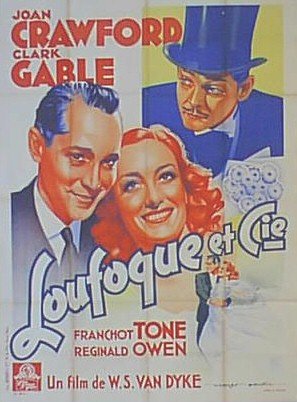
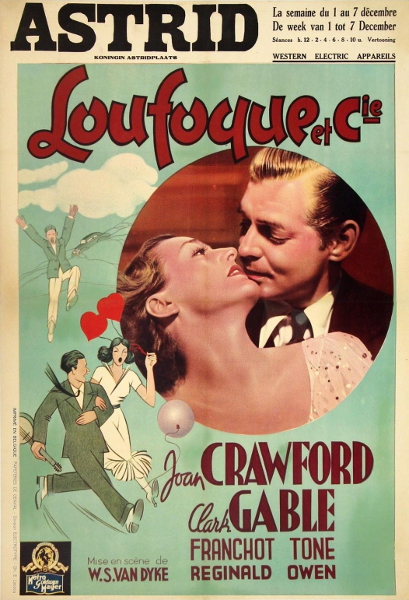
Above: Belgium. Below: Italy and Sweden.


Below: United States.
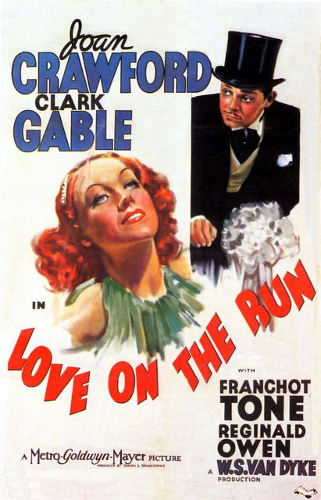
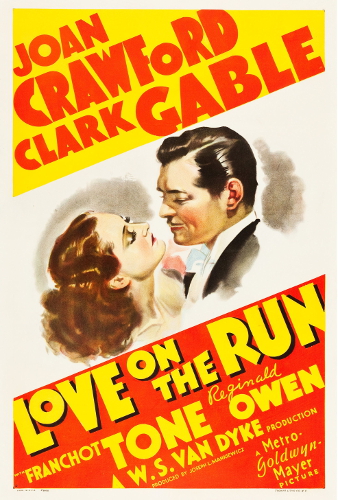
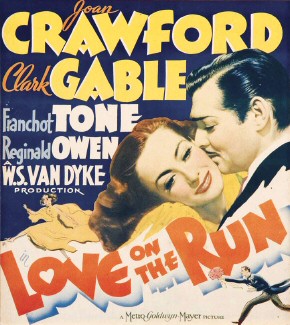
Below: US lobby cards
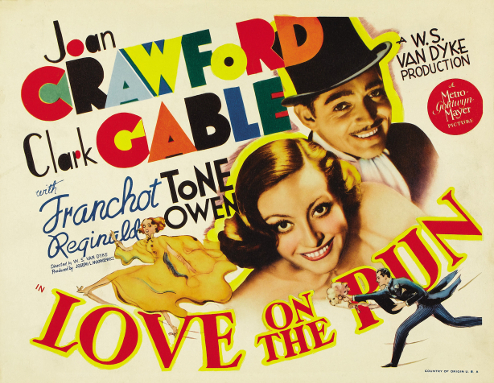
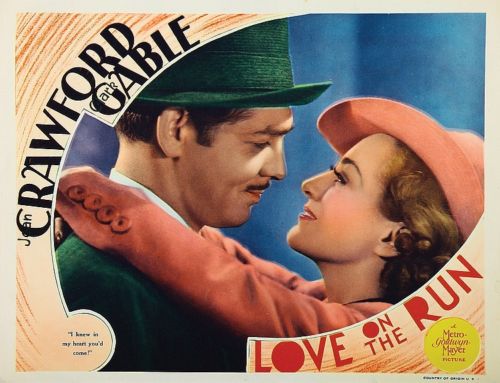

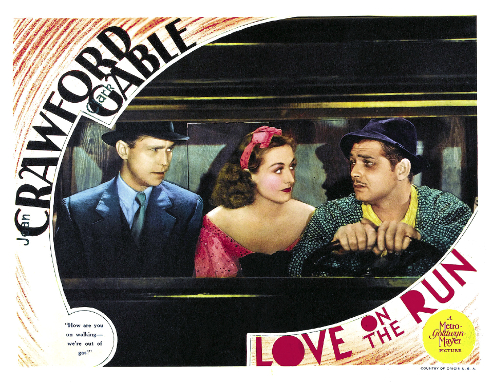
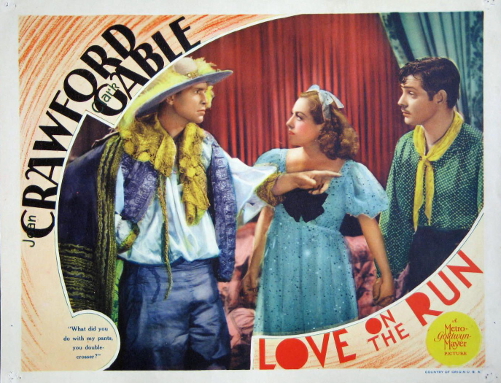

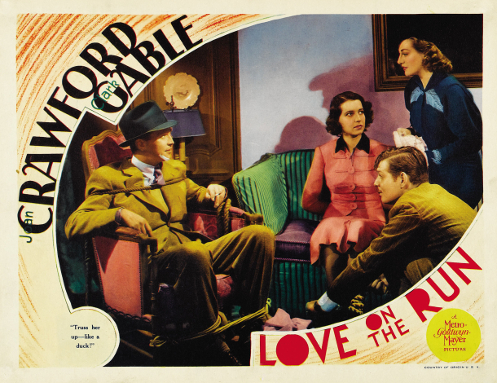
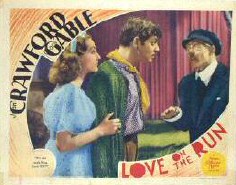
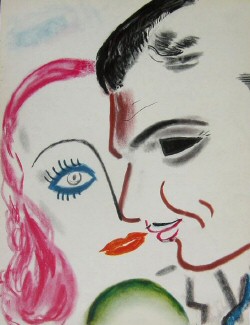
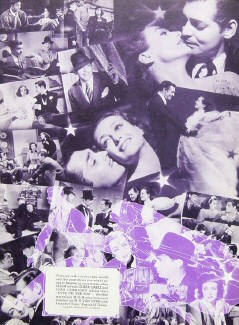

Above: US flyer cover, back cover, and close-up of back-cover blurb.
Below: US herald cover and centerfold.




Above: UK program cover and US window card art.
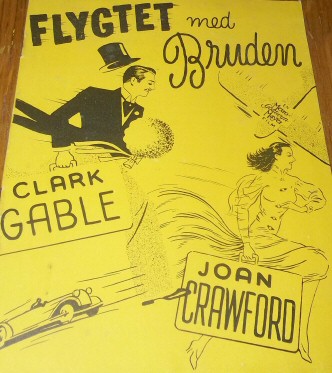
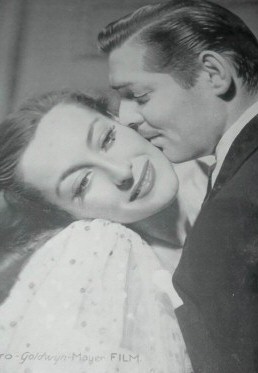
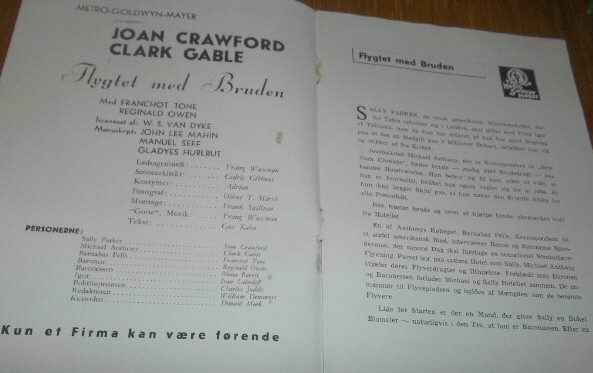
Above: Swedish program.
Below: Gilmer, Texas, newspaper ad; US trade ad; US glass slide; US and UK sheet music.
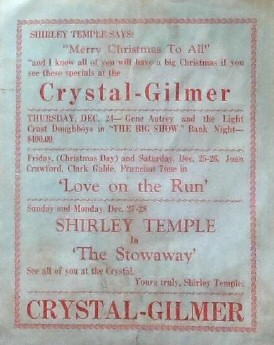

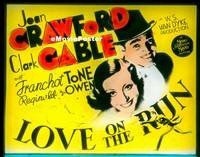


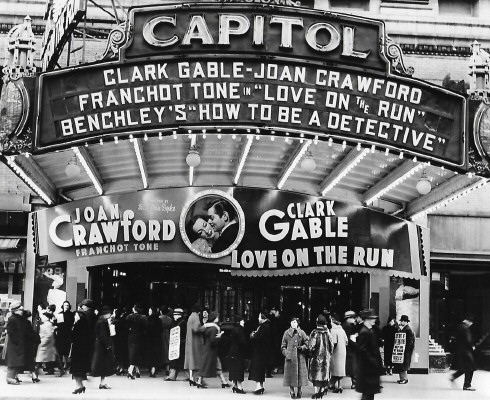
Above: At NYC's Capitol Theatre.
The Best of Everything